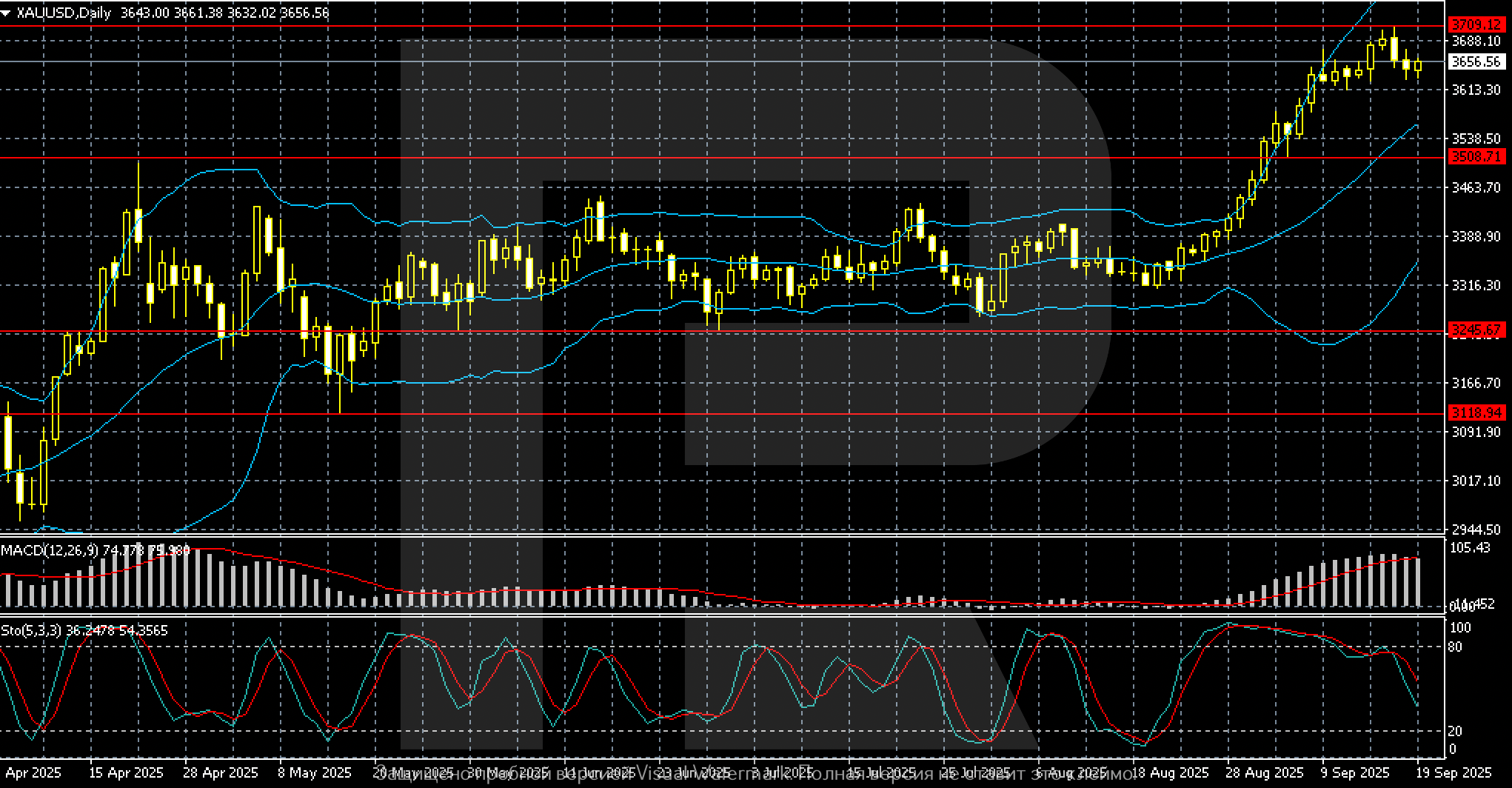Gold (XAUUSD) weekly forecast: time to pause and regain strength
Gold (XAUUSD) remained at 3,656 USD per ounce, hovering near local highs and close to historic levels. The metal receives support from expectations of a continued Fed rate-cut cycle following the September policy easing decision. Additional drivers include geopolitical uncertainty and sustained demand for safe-haven assets.
This analysis explores the key factors that may influence gold's movement during the week of 22–26 September.
XAUUSD forecast for this week: quick overview
- Weekly dynamics: gold (XAUUSD) remains above 3,612 after setting new records. The rally was supported by the Federal Reserve’s rate cut, weak US labour market data, and strong demand for safe-haven assets
- Support and resistance: the key support level lies at 3,612, followed by 3,508. A downward breakout would intensify a correction towards 3,44 The resistance level is at 3,674 and the all-time high of 3,709. An upward breakout would open the way to new record levels
- Fundamentals: gold gains support from expectations of dovish Fed policy, a weaker US dollar, and falling bond yields. Additional drivers include geopolitical risks and strong demand from central banks
- Outlook: the baseline scenario for 22–26 September is consolidation above 3,612 with potential growth to 3,674–3,709. A breakout below 3,612 would increase downside risks into the 3,508–3,440 zone
Gold (XAUUSD) fundamental analysis
Gold (XAUUSD) ended a three-day decline and recorded its first weekly loss in a month.
Market participants remain focused on the Federal Reserve. The regulator cut rates for the first time since December last year, leaving the door open for further easing. At the same time, it warned that high inflation may slow the pace of future moves. Jerome Powell called the decision a measured response to labour market weakness and stressed that the Fed does not intend to accelerate the easing cycle.
Despite the short-term correction, gold has gained around 40% year-to-date. Regular new all-time highs reflect expectations of continued Fed easing, geopolitical risks, and strong central bank demand.
Another supporting factor is demand from China. Official statistics show that Swiss gold exports to China rose by 254% in August compared to July.
XAUUSD technical analysis
On the daily timeframe, gold (XAUUSD) has consolidated above the 3,508 level and continues to trade near all-time highs. After reaching 3,709, prices corrected to 3,656, where it is currently consolidating.
Support levels are at 3,612 and 3,508. A breakout below these levels could open the way to deeper zones at 3,245 and 3,118. Resistance remains around 3,709; consolidation above this level would support a move to new all-time highs.
MACD remains in positive territory, but the signal line is approaching the histogram, indicating a potential slowdown in momentum. The Stochastic has turned downwards from the overbought zone, confirming the likelihood of a short-term correction.
Overall, the technical picture remains bullish, although the current phase is consolidation with downside risks before another attempt at growth.
XAUUSD trading scenarios
The fundamental backdrop remains in favour of buyers. Support for demand comes from expectations of continued Federal Reserve easing, strong interest in safe-haven assets, and persistent geopolitical risks.
- Buy scenario
Long positions remain relevant if prices hold above the 3,612 support level. A bounce from this level could push prices towards 3,674 and then 3,709, which marks historical resistance. An additional catalyst could be falling US bond yields and weak US labour market data.
- Sell scenario
Short positions are possible if prices break below the 3,612 level. In this case, targets shift to 3,508 and 3,440. The downside momentum could strengthen amid strong US macroeconomic data and rising Treasury yields, which would bolster the US dollar and weaken gold’s appeal.
Conclusion
Gold remains within the 3,612–3,709 range. The baseline scenario suggests consolidation above 3,612 with the potential to reach new record highs if the Fed maintains dovish rhetoric.
A breakout below 3,612 would signal a deeper correction towards 3,508.
Summary
Gold (XAUUSD) is hovering near record levels, supported by expectations of continued dovish Federal Reserve policy and signs of a cooling US labour market. All of this increases interest in safe-haven assets.
Gains remain limited by strength in equity indices. Geopolitical tensions and US trade measures pose additional risks.
The key support level lies at 3,612, with resistance at 3,674 and 3,709. A breakout above 3,709 would open the way to new record highs, while consolidation below 3,612 increases the likelihood of a decline towards 3,508 and 3,440. As long as prices remain at the upper boundary of the range, gold will remain sensitive to macroeconomic data and political developments.
Forecasts presented in this section only reflect the author’s private opinion and should not be considered as guidance for trading. RoboForex bears no responsibility for trading results based on trading recommendations described in these analytical reviews.


